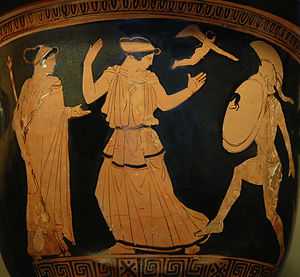Sappho's Fragment 16
Fragment 16 is a poetic remnant by Sappho, a female poet who lived in Lesbos during the 7th century B.C. It is often referred to by the title "To an Army Wife, in Sardis". This fragment presents a feminine perspective on what beauty is, drawing allusions to both unknown figures from Sappho’s time such as Anaktoria, as well as figures from Greek myth such as Homer’s Helen. Though not a direct retelling of Homer’s poetry, this fragment imitates his narrative themes and poetic style.
Poem Text
| Original Greek (Sappho’s Poems) |
|---|
|
Οἰ μὲν ἰππήων στρότον, οἰ δὲ πέσδων, |
Possible continuation after line 20
There is scholarly contention as to whether this poem continues after line 20. One possible reconstruction has been proposed by Jakob Sitzler. He proposes that lines 21–22 of fragment 16 read as follows: ἀλλ’ ἄραν] μὲν οὐ δύνατον γένεσθαι / παῖσ]α̣ν ἀνθρώπ[ωι, π]εδέσχην δ’ ἄρασθαι (“but it is not possible that every wish / for a human is fulfilled, but to pray to partake in…”). [1] Edwin Marion Cox has given the following:[2]
εὶ μεν ἴδ]μεν οὔ δύνατον γένεσθαι
λῷστ᾽] ὀν᾽ ἀνθρώποισ, πεδέχην δ᾽ ἄρασθαι,
[τῶν πέδειχόν ἐστι βρότοισι λῷον]
[ἢ λελάθεσθαι.]
So must we learn in world made as this one
Man can never attain his greatest desire,
[But must pray for what good fortune Fate holdeth,
Never unmindful.]
Connections to Homer and Greek Myth
Love is a theme and motivator which falls far secondary to the glory attainable through militaristic greatness in Homer’s Iliad, yet the theme of longing for love resonates clearly throughout this fragment.[3] The speaker of this poem clearly characterizes Helen and gives her authority from the very priamel structure (listing alternative descriptions) of the initial stanza. By opening with a list three distinctly masculine opinions before presenting one of definitive disagreement, the tone of assertive dissent prefaces and solidifies the persona of Helen who is addressed in the subsequent quatrain.[4] The speaker also stresses the importance of the individual's view point as opposed to a community consensus through this nexus of opinions, as fortified through the speaker's juxtaposition of Helen's decision.[5] This fragment Sappho not only contends Homer’s stance on the types of beauty which wield merit, but she gives a voice to a character of Homer’s creation who he did little to develop.
Much like Homer’s glimpses of Helen in the Iliad, the fragment is restless in both form and tonal pattern, gathering logic into itself rather than unfolding it through rational sequence.[4] The fragment serves to present a female perspective on the priorities in life during war. And much as in Fragment 44, Sappho augments her Homeric references with details of the circumstances in Lesbos at the time of her floruit: she refers to the attacking Lydians whose military insistently threatened her region.[6]
Sappho's uses of imagery imitate the style of Homer, emphasising beauty of the individual over beauty in aggression. The visual images describing Anaktoria's complexion and gait, for instance, add both authentic and sentimental aspects to the tone.[7] She presents a set of wartime values alternative to the standard masculine view of her time, using the myth of Homer’s Helen as the poetic medium.[8]
References
- ↑ André Lardinois, "The New Sappho Poem (P. Köln 21351 and 21376): Key to the Old Fragments," Classics@ Volume 4: Ellen Green and Marilyn Skinner, eds. The Center for Hellenic Studies of Harvard University, online edition of March 9, 2011. http://chs.harvard.edu/wa/pageR?tn=ArticleWrapper&bdc=12&mn=3534.
- ↑ Sappho’s Poems
- ↑ Lesky, Albin. A History of Greek Literature. Hackett Publishing Company, Inc.: Indianapolis, 1996. pg. 142.
- ↑ 4.0 4.1 Carson, Anne.If Not, Winter: Fragments of Sappho. Vintage Books: New York, 2002. pg. 362.
- ↑ Rutherford, Richard.Classical Literature: A Concise History. Wiley-Blackwell, 1991. pg. 67.
- ↑ Reynolds, Margaret. The Sappho Companion. Palgrave: New York, 2001.
- ↑ Johnson, Marguerite. Sappho. Duckworth Publishers: 2007. pg. 70.
- ↑ Rutherford, Richard. Classical Literature: A Concise History. Wiley-Blackwell: 1991. pg. 151.
